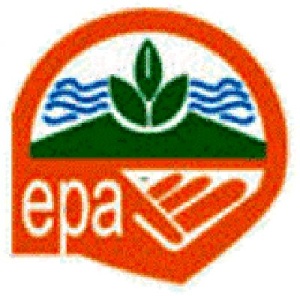Some of the companies perceived as bigger, more powerful and influential score very low marks in environmentally responsible operations, according to the investigations conducted into the Akoben programme of the Environmental Protection Agency (EPA) of Ghana.
The likes of AngloGold Ashanti Limited, Goldfields Ghana Limited, Ghana Bauxite Company Limited and Prestea Sankofa Gold Limited can be listed as the poorest performing companies in environmentally responsible operations, our analysis has shown.
The Akoben programme is an environmental performance rating and disclosure initiative of the EPA, which uses a five-colour rating scheme to assess the environmental performance of mining and manufacturing operations.
The five colours are Gold, Green, Blue, Orange and Red, indicating environmental performance ranging from excellent to poor.
Over the period 2009 to 2012, Ghana Manganese Company Limited, Chirano Gold Mines Limited and Newmont Ghana Gold Limited in Kenyasi have emerged tops among 16 mining companies.
Break down
Overall 16 mining companies have featured in the Akoben process since 2009. Only Newmont Golden Ridge Resources at New Abirem and Noble Gold Bibiani Limited in Bibiani have been involved in the process on a single occasion (2012).
On the other hand, Adamus Resources Limited in Teleku Bokazo, Owere Mines Limited of Konongo and Perseus Mining Limited in Ayanfuri have been involved twice (2011 and 2012).
All the rest, including AngloGold Ashanti (Iduapriem) Limited, AngloGold Ashanti Limited (Obuasi Mine), Goldfields Ghana Limited (Tarkwa Mine), Newmont Ghana Gold Limited in Kenyasi, Prestea Sankofa Gold Limited and Abosso Goldfields Limited in Damang have all appeared in all of the editions.
Other four-time participants are Chirano Gold Mines Limited, Ghana Bauxite Company Limited in Awaso, Ghana Manganese Company Limited in Nsuta, Golden Star (Bogoso/Prestea) Limited based in Bogoso and Golden Star (Wassa) Limited in Akyempim.
Our analysis
In order to get a clear picture of who is doing well in the EPA's process, we substituted the colour codes with numerical values where Red (poor) performance is represented by 1 and Gold (excellent) performance is represented by 5. Orange (unsatisfactory), Blue (good) and Green (very good) are represented with 2, 3 and 4 respectively.
Among the four-timers, none scored 5 (Gold) in any of the editions. Overall, the best performance comes from Ghana Manganese Company Limited which polls 12 points cumulatively, improving from a score of 2 (Orange) in both 2009 and 2010 to 4 (Green) in 2011 and 2012.
Chirano Gold Mines Limited ranks a close second with an aggregate score of 10 after picking 2 in each of 2009, 2010 and 2011 before jumping to 4 in 2012. In spite of a fluctuating performance, Newmont Ghana Gold Limited in Kenyasi clocks aggregate of 9 points to place third, picking up two (2009), three (2010), two (2011) and three (2012).
The poorest performances come from AngloGold Ashanti Limited (Obuasi Mine), Ghana Bauxite Company Limited in Awaso, Goldfields Ghana Limited (Tarkwa Mine) and Prestea Sankofa Gold Limited. All these companies scored 1 point (Red) in each of the four editions to aggregate 4 points over the period.
They place just behind Golden Star (Bogoso/Prestea) Limited and AngloGold Ashanti (Iduapriem) Limited which score five points each over the period.
In between the top and bottom performers are Abosso Goldfields Limited in Damang and Golden Star (Wassa) Limited in Akyempim which score eight points apiece.
Several attempts at reaching the EPA for its comments on the analysis were unsuccessful but the regulatory body posts on its website that “These ratings measure the environmental performance of companies based on their day-to-day operations once they have successfully cleared their Environmental Impact Assessments (EIA) and obtained their environmental permit to operate.”
Also, it said, the ratings are evaluated by analysing more than a hundred performance indicators that include quantitative data as well as qualitative and visual information.
The EPA reports its final ratings as aggregates of assessment of companies in areas such as Legal Issues, Hazardous Waste Management, Toxics Releases, Non-Toxics Releases, Monitoring and Reporting, Environmental Best Practices, Community Complaints and Corporate Social Responsibility.
Meanwhile, studies and anecdotal evidences have shown that the first consequence of environmental breaches is the pollution of water bodies.
In October 2011, the Centre for Environmental Impact Analysis (CEIA), based in Cape Coast, and its partners revealed in a study conducted in the Prestea-Huni Valley (including Bogoso-Dumasi), Tarkwa Nsuaem and Cape Coast municipalities that high levels of toxic metallic substances, particularly Arsenic were present in rivers, streams, boreholes and food crops due mainly to the exposure of these substances by the activities of miners – large and small scale alike.
Some three years before then, CEIA and Wacam had jointly researched that out of the 160 streams/rivers in the Obuasi mining area in the Ashanti Region, 145 were perceived by residents to be polluted by the operations of mining companies and galamsey operators. Similarly, all the 117 rivers/streams in the Tarkwa mining area were also perceived to be polluted.
For many, the trend shows that very few companies are taking the initiative seriously. Thus, there is need for the EPA to revise the programme from a “naming and shaming” process to a punitive one.
The likes of Mrs Hannah Owusu Koranteng, Associate Executive Director at Wacam, have a problem with the process and how primary data is sourced as well as the impact it is making.
“I don't think the Akoben has made mining companies more responsible. I think the EPA should do more as a regulatory body and stop this window dressing,” she asserts, explaining that “Akoben environmental accountability is good, but I doubt whether the way we are organizing it in Ghana will bring out the needed lessons.”
She further expatiates, “I'm saying this because if you look round, we have huge environmental deficit and when EPA continuously comes out and say that companies are improving on their environmental stewardship then I have a problem.
“I also have a problem with the stakeholders that get involved in the Akoben assessment because if you want to do a correct assessment of how people feel about the environmental situation, the first source of information is the communities that are affected,” she pointed out.
She also disagrees with the indexing. “I don't understand why they should be adding Corporate Social Responsibilities as an index for Akoben process.”
Similar sentiments come from Richard Ellimah, Executive Director of the Obuasi-based Centre for Social Impact Studies (CeSIS).
Mr Ellimah had a word of praise for the imitative. “The Akoben initiative is a very good step the Environmental Protection Agency took in regulating mining industries in Ghana. Though still very young, Akoben comes to add up to already existing initiatives. One unique thing about it is that it is home grown, unlike other standards that are international in nature.”
He then jabs, “I am not sure there is civil society input in the entire process. This also underlies some of the deficiencies of the process. Currently apart from the industry, the criteria for rating companies are still unknown. This clearly is an anomaly that has to be rectified.”
He perceives that there is an “apparent show of apathy by mining communities towards the Akoben, though admittedly it could be a powerful tool for environmental and social advocacy in the communities.”
In spite of the criticisms, he admitted, “The Akoben has made mining companies a little more environmentally responsible than they were in the past. I believe scoring well on the ratings has become more of a status symbol within the industry, something like a badge of honour they wear.”
From the point of view of Goldfields Ghana Limited, sometimes the fault is not entirely that of companies. Construction activities and illegal miners can contribute to the scores a company gets.
Mr Chris Debrah, Environment Superintendent of the company said, “If there is any issue that will affect rating such as the colour of water that runs through your mine but is being polluted because of a construction or illegal mining, popularly known as galamsey that would result in exceeding the regulatory parameters, you need to alert the regulators.”
Regardless of stagnating at Red in the Akoben ratings, Goldfields considers the process impactful, according to Mr Debrah. “The institution of Akoben rating and public disclosure is helping mining industry to be on their toes.”
He explained in an interview that the rating scheme has helped mining companies to be alive to their environmental responsibility. They are mindful of the dangers of water quality, dust, noise pollution from blasting, attitude towards resolving community complaints, and adoption of best practices on mining site.
Companies are mindful of the data submitted. Cos of the public disclosure the mining company is trying to avoid red rating though the standard is very high set at about 98%.
Goldfields strategy for avoiding the red rating has been to improve environmental awareness, incentivize workers more, recognizing environmental issues as essential, core to operations and business planning of the mining operations.
“Every employee knows what Akoben is and it has improved their attitudes so there is no littering, and there is significant investment to prevent pollution,” Mr Debrah disclosed.
Determined to change its fortunes in the ratings, Mr Debrah said Goldfields strives always for continual improvement depending on best technology and its availability adapted.
“We do not dispose waste in a normal in landfill like a dug up hole but into a specially designed landfill lined with HPP material to ensure there is no interaction between the soil and waste,” he intimated.
Business News of Sunday, 26 April 2015
Source: Public Agenda













